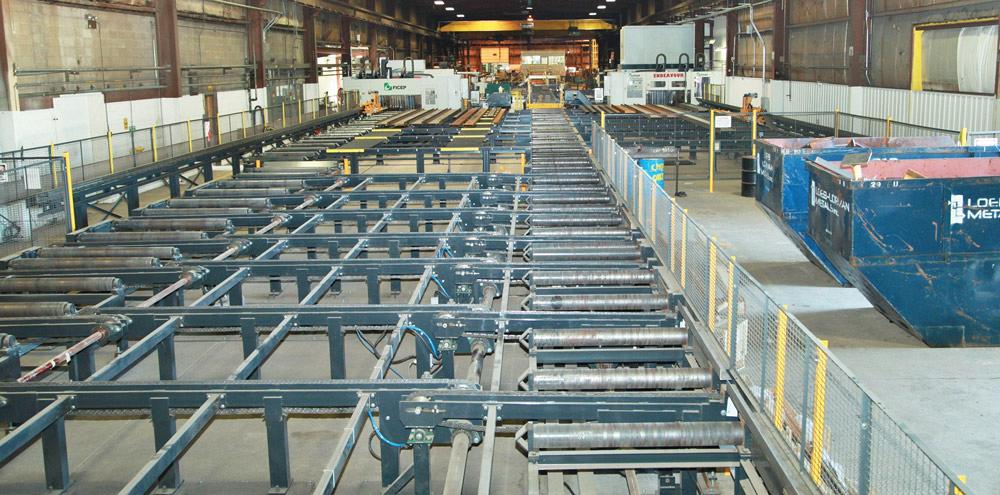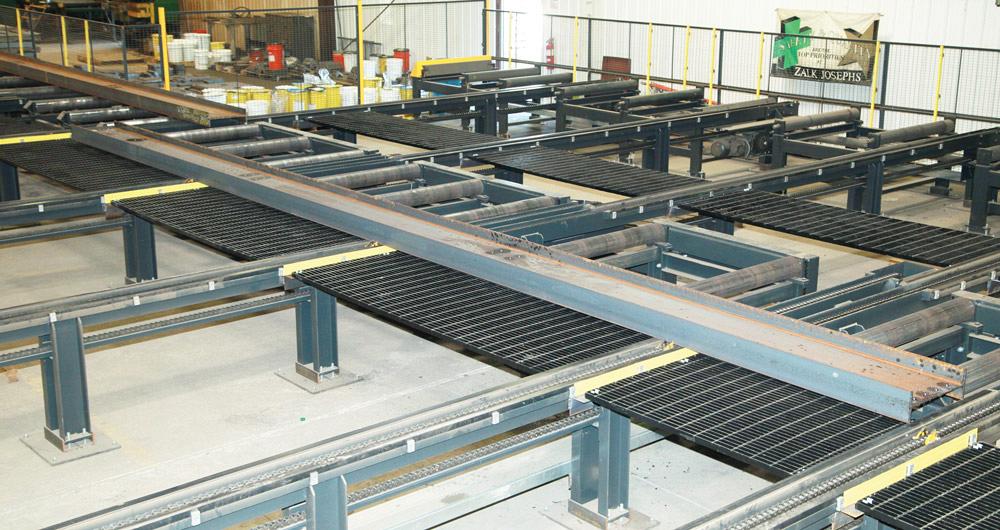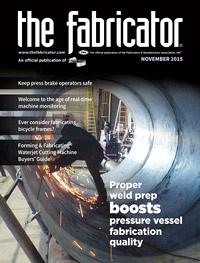Contributing Writer
- FMA
- The Fabricator
- FABTECH
- Canadian Metalworking
Categories
- Additive Manufacturing
- Aluminum Welding
- Arc Welding
- Assembly and Joining
- Automation and Robotics
- Bending and Forming
- Consumables
- Cutting and Weld Prep
- Electric Vehicles
- En Español
- Finishing
- Hydroforming
- Laser Cutting
- Laser Welding
- Machining
- Manufacturing Software
- Materials Handling
- Metals/Materials
- Oxyfuel Cutting
- Plasma Cutting
- Power Tools
- Punching and Other Holemaking
- Roll Forming
- Safety
- Sawing
- Shearing
- Shop Management
- Testing and Measuring
- Tube and Pipe Fabrication
- Tube and Pipe Production
- Waterjet Cutting
Industry Directory
Webcasts
Podcasts
FAB 40
Advertise
Subscribe
Account Login
Search
Is manual material handling necessary in the structural steel fab shop?
Automation can make moving structural pieces much simpler
- By Tom Boyer
- October 28, 2015
- Article
- Materials Handling

Figure 1
As structural steel fabricators deemed crane picks to be a wasteful way to move material in a shop, they turned to conveyors and cross-transfer systems, some of which were very long and took up a lot of space.
Structural steel fabricators have had a difficult time getting a handle on moving beams and heavy sections over the past decades.
If you consider the industry prior to the 1960s and 1970s, you will recall nearly all fabricators had to spread out sections on work skids for manual layout of one surface at a time, and then rotate them to the second, third, or even fourth side. Once the manual layout was accomplished, the holes were produced with an oxyfuel torch, reamed to size, and drilled with a magnetic base drill or sometimes punched with a portable hydraulic punch machine. Once the layout and holes were produced and the necessary welding was accomplished, the structural steel piece possibly was painted in place or moved by crane to an area in the shop that was segregated for painting.
In the early 1970s, beam lines started to enter the market, which helped to eliminate manual layout. How holes were produced substantially changed, and production costs were reduced significantly. However, beam lines did introduce additional crane handling steps as the process now required the member to be moved to the workcenter rather than just having the worker move to the material.
As the machine tool industry developed enhanced fabrication technologies related to processes such as sawing and thermal coping, structural steel shops had to undertake even more manual material handling. Fabricators were more efficient from a production standpoint, but the number of material handling steps they had to take increased significantly. What used to take just a few material handling steps to complete work on a structural steel member in the 1960s and 1970s now required the worker to move the member more than 10 times with a crane, on average.
At that time in fabricating history, a fabricator could make the argument that the material handling was a necessary evil to take advantage of new fabrication technologies. However, modern fabricating has taught today’s manufacturers otherwise. With each crane pick, significant cost is added to the job because the completion of the job is delayed. The fabricator can’t get paid until the job is complete and delivered. Also, the customer is not paying for material movement, just the fabrication activity. By spending time moving material around, the fabricator is not increasing the value of the work-in-process.
Complexity and Size Increase
Fabricators around the world started to take the next step to add conveyors and cross-transfer systems to eliminate the need to crane-handle material between operations (see Figure 1). However, the complexity and length of these material handling systems grew substantially. They became a derivative of a fabricator’s existing facility, desired capacity, and plant layout.
Depending on the application, a cross conveyor or transfer table setup is one of three basic designs:
- Chain-driven dogs for traverse movement of single members, which accounts for most applications (see Figure 2).
- Lift-and-carry transfer carts for heavier sections or to move multiple pieces simultaneously.
- Chain runners for loading and unloading multiple sections to a conveyor line simultaneously, such as material handling for a shotblast system (see Figure 3).
It is not unusual to have all three different types of transfer designs incorporated into the same system depending on the plant’s layout, processes, and requirements.
As the productivity and capability of CNC workcenters improved, the need to enhance the efficiency of the material handling became more apparent. Until recently, humans controlled the material handling systems. An operator would transfer one section at a time and convey each member to the proper lineal position for movement to the next operation.
While the operator managed the material handling system, the CNC line was not producing, and the shop was not making money because non-value-added activity was taking place.

Figure 2
Like leading a dog on a leash, this conveyor allows the structural steel member to traverse the conveyor system.
Automation Changes the Game
Full system automation, which has become known as intelligent steel fabrication, is now a reality. It begins with an integrated software platform that downloads the 3-D design model to establish the required sections that are to be fabricated.
All the common-size elements are nested at maximum efficiency not only to minimize the stock length utilization, but also to nest by common machine operations to achieve the optimum CNC workcenter efficiency. Before the job is processed, a computer simulation is generated in accelerated time to predict production bottlenecks. Any potential backups then can be eliminated by resequencing, and an actual production time for shop scheduling is attained.
Once the job has been downloaded from the model, a listing of the required sections to be loaded is generated, so a material handler can load the required stock lengths and bar code-scan each length as it is entered into the system. From this point, intelligent steel fabrication takes over as all material handling functions are fully automatic, even down to the removal of trim cuts on the sawing systems.
Each layout is customized for the fabricator’s production requirements and plant configuration. The software is tailored to accommodate the different processes that are part of the system. Because the software knows the fabricator’s requirements for each part, the routing of the section is directed to the most productive CNC machine to accomplish the required task. As a section enters a CNC workstation, the correct CNC program is matched with the structural steel section without manual intervention.
While the separate CNC processes are operating without operator intervention, the necessary material handling functions and related movements of the members are being processed simultaneously. Because the material handling system is CNC, the fabricator can see the sections in process with their part numbers and actual locations in the system in real time via a graphic user interface (see Figure 4).
The ability to fully automate the material handling so it can occur simultaneously with CNC fabrication provides a new level of productivity that the industry has not experienced previously. Traditionally, the industry tried to expand the throughput of a system layout by increasing the number of stand-alone workcells, which called for more saws, drills, and copers. This approach drastically increased the level of investment, plant space requirement, and the complexity of a manual material handling system that required even more operator involvement while reducing the percentage of time that the CNC systems were producing.
Now past jobs can be run through the simulation software to show the relative efficiency of a proposed layout and project the number of tons that can be produced with it. This approach enables a fabricator to expand capacity more confidently, while decreasing its level of investment and reducing the labor-hours per ton. It also maximizes valuable floor space.
Smaller Footprint, Bigger Production
The total efficiency of intelligent structural steel fabrication enables more compact system layouts (see Figure 5) when compared to lines from the end of the 20th century. Those dated system layouts required more than twice the shop space, yet produced substantially fewer tons per hour of fabricated structural steel than these new compact layouts.
Where do material handling cost and productivity go from here? One can only assume the same question was asked each time a new fabricating technology was introduced over the past several decades.
About the Author
Related Companies
subscribe now

The Fabricator is North America's leading magazine for the metal forming and fabricating industry. The magazine delivers the news, technical articles, and case histories that enable fabricators to do their jobs more efficiently. The Fabricator has served the industry since 1970.
start your free subscription- Stay connected from anywhere

Easily access valuable industry resources now with full access to the digital edition of The Fabricator.

Easily access valuable industry resources now with full access to the digital edition of The Welder.

Easily access valuable industry resources now with full access to the digital edition of The Tube and Pipe Journal.
- Podcasting
- Podcast:
- The Fabricator Podcast
- Published:
- 04/16/2024
- Running Time:
- 63:29
In this episode of The Fabricator Podcast, Caleb Chamberlain, co-founder and CEO of OSH Cut, discusses his company’s...
- Trending Articles
How to set a press brake backgauge manually

Capturing, recording equipment inspection data for FMEA

Tips for creating sheet metal tubes with perforations

Are two heads better than one in fiber laser cutting?

Hypertherm Associates implements Rapyuta Robotics AMRs in warehouse

- Industry Events
16th Annual Safety Conference
- April 30 - May 1, 2024
- Elgin,
Pipe and Tube Conference
- May 21 - 22, 2024
- Omaha, NE
World-Class Roll Forming Workshop
- June 5 - 6, 2024
- Louisville, KY
Advanced Laser Application Workshop
- June 25 - 27, 2024
- Novi, MI



























